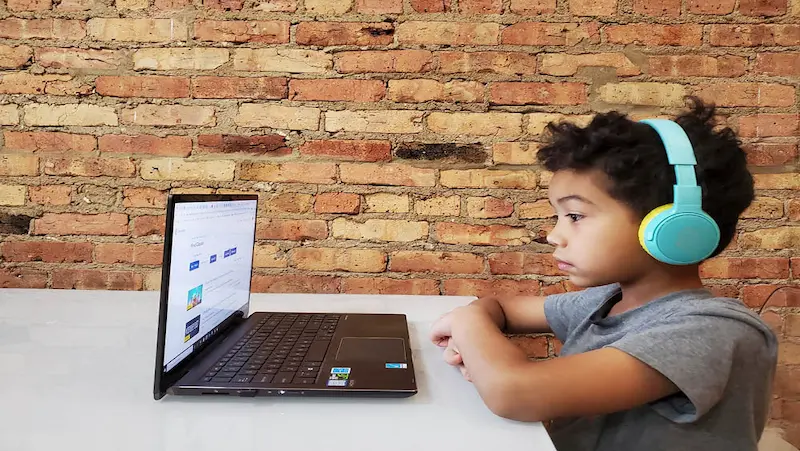In the ever-evolving landscape of education, virtual learning for kids has emerged as a pivotal tool for shaping the minds of our little learners. In a world where technology is woven into the fabric of daily life, embracing virtual learning for kids is not just a trend but a necessity. It’s like giving children a passport to an expansive world of knowledge, right from the comfort of their homes.
This digital shift in education isn’t just about convenience; it’s a game-changer in fostering curiosity and adaptability in our kids. Imagine classrooms without borders, where a child in one corner of the globe can share ideas with someone miles away. Virtual learning for kids opens up a treasure trove of resources, making lessons engaging, interactive, and tailored to individual needs.
Moreover, it teaches our young minds tech-savvy skills, preparing them for a future where the ability to navigate the virtual realm is as crucial as knowing how to read and write. In essence, embracing virtual learning for kids isn’t just keeping up with the times; it’s about giving our children the tools to thrive in a world that’s constantly evolving.
Table of contents
Early Childhood (Ages 3-6)
Ah, the delightful world of early childhood, where every day is an adventure and learning is wrapped in the joyous embrace of play. For our tiny tots aged 3 to 6, interactive and playful platforms serve as the magical gateways to a realm of discovery.

Interactive Wonderland for Little Explorers
Picture this: a colorful universe where learning is disguised as play. Platforms like ABCmouse and Fisher-Price Play Lab are the virtual playgrounds where tiny fingers tap, swipe, and giggle their way through the first chapters of education. These platforms offer a blend of enchanting visuals and simple interactive games, engaging the youngest learners in a dance of knowledge and fun facts for kids.
Educational Games: Where Fun Meets Learning
Who says learning can’t be a game? Not these platforms! Educational games for kids tailored for our pint-sized scholars are the secret sauce. From counting colorful cupcakes to solving playful puzzles, these games for kids ensure that every “aha” moment is accompanied by a burst of laughter. It’s not just about the fun; it’s about laying the foundation for essential skills like numeracy, literacy, and problem-solving.
Storytelling Adventures: Where Imagination Takes Flight
In the world of early childhood, storytelling is more than words on a page—it’s a journey. Platforms like Homer and StoryBots spin tales that captivate young minds, blending vibrant visuals with interactive elements. These digital story hours not only kindle a love for narratives but also nurture language skills and spark creativity.
Foundational Learning: Building Blocks for Bright Futures
From mastering the ABCs to getting cozy with numbers, these platforms ensure that our little learners are building a rock-solid foundation. ABCmouse, for instance, guides our tots through a world where letters and numbers become their trusted companions, setting the stage for a lifelong love affair with learning.
In this enchanting phase of early childhood, these interactive and playful platforms aren’t just tools; they’re the architects of a future rich with curiosity and knowledge. So, let the laughter echo through the digital corridors of education as our youngest adventurers take their first steps into the captivating world of learning through play.
Elementary School (Ages 7-12)
Embarking on the journey of education with young minds is a delightful adventure. In the realm of Elementary School (ages 7-12), it’s crucial to find platforms that make learning not just informative, but downright fun! Here, we’re shining a light on some gems that offer structured lessons, making education an exciting playground for your little ones.

Structured Lessons, Big Discoveries:
Imagine a world where learning isn’t a chore but a captivating journey. Platforms tailored for elementary schoolers offer structured lessons in various subjects, turning each topic into a new realm of exploration. These lessons are like stepping stones, guiding our young learners through the wonders of language, math, science, and more.
Adaptive Learning – Tailoring Education to Uniqueness:
No two learners are alike, and that’s where adaptive learning steps in. Picture this: a platform that adapts to your child’s pace, understanding their strengths and gently nudging them forward where they need it most. It’s like having a personalized tutor, ensuring that every “aha” moment is celebrated and every challenge is met with support.
Quizzes that Spark Excitement:
Who said quizzes had to be dull? In the world of elementary education, quizzes become an exciting game. These bite-sized challenges not only test knowledge but also foster a sense of achievement. Correct answers light up faces, and even the not-so-correct ones become stepping stones for growth. It’s the kind of friendly competition that makes learning an adventure.
Engaging Content – Because Learning Shouldn’t be Boring:
Remember the days when textbooks seemed to weigh more than our backpacks? Well, not anymore! Engaging content is the hero of modern education platforms. From interactive videos for kids to colorful illustrations, learning materials are designed to captivate young minds. Education becomes a tapestry of sights and sounds, making it more than just absorbing facts – it’s about experiencing the joy of discovery.
In the world of elementary education, these platforms are the guiding stars. They transform learning into a vibrant, dynamic experience, creating a foundation that lasts a lifetime. So, here’s to the joy of learning and the boundless possibilities that await our young scholars!
Middle and High School (Ages 13-18)
Ah, the rollercoaster ride of teenagehood – a time of growth, self-discovery, and, of course, education. As our young minds venture into the realms of middle and high school (ages 13-18), the need for a solid academic foundation becomes more apparent than ever. Lucky for them, the digital era has ushered in a wave of platforms designed to make learning not just a chore, but an exciting journey.

Unleashing the Academic Arsenal
Think of these platforms as your teen’s secret academic weapon. They go beyond the basics, offering courses that delve into the nitty-gritty of subjects, providing a depth that traditional textbooks might miss. From advanced math to literature that makes you ponder, these platforms are here to turn the light bulbs on in those curious minds.
More Than Just Textbooks: Interactive Adventures
Gone are the days of monotonous lectures and dry textbooks. Enter: interactive learning. Imagine your teen engrossed in lessons that feel more like an adventure than a lecture. Videos, virtual labs, and engaging activities for kids– learning becomes an experience, not a task. These platforms are all about making education as captivating as the latest social media trends.
Lights, Camera, Learn: Video Lectures Take Center Stage
Who needs a boring blackboard when you can have video lectures stealing the show? These platforms recognize that visual learning is the real MVP. Complex concepts are broken down into digestible video snippets, making even the trickiest subjects a piece of cake. It’s like having a personal tutor on demand, without the awkward silences.
Mastering the Exam Game
Exams might send shivers down the spine, but these platforms have your teen covered. They’re not just about filling brains with knowledge; they’re about preparing for the big day. From practice exams to tips and tricks for acing tests, these platforms understand that success is not just about what you know but how you showcase it.
In the world of middle and high school education, these platforms are the sidekick your teen needs. They’re not just guides; they’re companions in the journey of knowledge, turning the academic climb into a thrilling adventure. So, buckle up, because the future of learning is here, and it’s anything but ordinary.
Conclusion:
In the grand journey of shaping a child’s education, the significance of choosing the right platforms cannot be overstated. Just as a sturdy foundation is crucial for a building, selecting appropriate educational tools lays the groundwork for a child’s learning adventure. It’s like finding the perfect pair of shoes – the right fit ensures a comfortable and enjoyable walk.
In a world filled with countless options, picking platforms that resonate with a child’s unique learning style, interests, and pace can make all the difference. It’s akin to unlocking a door to a world of possibilities, where curiosity is sparked, confidence grows, and knowledge becomes a trusted companion.
The responsibility lies not just in the hands of educators but extends to parents and caregivers. Understanding the potential of various platforms, their strengths, and alignment with educational goals allows us to crafts for kids an enriching environment for our young learners. It’s like cultivating a garden, nurturing the seeds of knowledge with the right blend of sunlight, water, and care.
In essence, the journey of education is a partnership – a collaboration between the child, the educators, and the tools they use. By choosing wisely, we pave the way for a future where learning is not just a task but a joyful expedition. After all, the right platforms are not just tools; they are companions in the adventure of growing, exploring, and understanding the vast landscape of knowledge.
To get your hands on more such articles, educational content, and free resources on coding classes for kids, online robotics classes for kids, game development, etc., check out the BrightCHAMPS Page now!
Frequently Asked Question
A1: The best virtual learning platforms for kids cater to various age groups, offering a wide range of educational content and features.
A2: Yes, many platforms provide interactive and engaging content for the youngest learners, focusing on early childhood education.
A3: Absolutely. There are platforms that offer a diverse curriculum, from math and science to arts and coding, for older children and teenagers.
A4: Yes, there are free or low-cost options, making virtual learning accessible to families with varying budgets.
A5: Many platforms offer features for parents to monitor their child’s progress and ensure a safe and productive learning environment.
A6: Some platforms offer virtual classrooms, allowing kids to interact with teachers and other students, fostering social interaction and collaboration.
A7: Select a platform based on your child’s age, interests, and learning goals, and read reviews or seek recommendations for guidance.


 We are an army of educators and passionate learners from BrightChamps family, committed to providing free learning resources to kids, parents & students.
We are an army of educators and passionate learners from BrightChamps family, committed to providing free learning resources to kids, parents & students.








